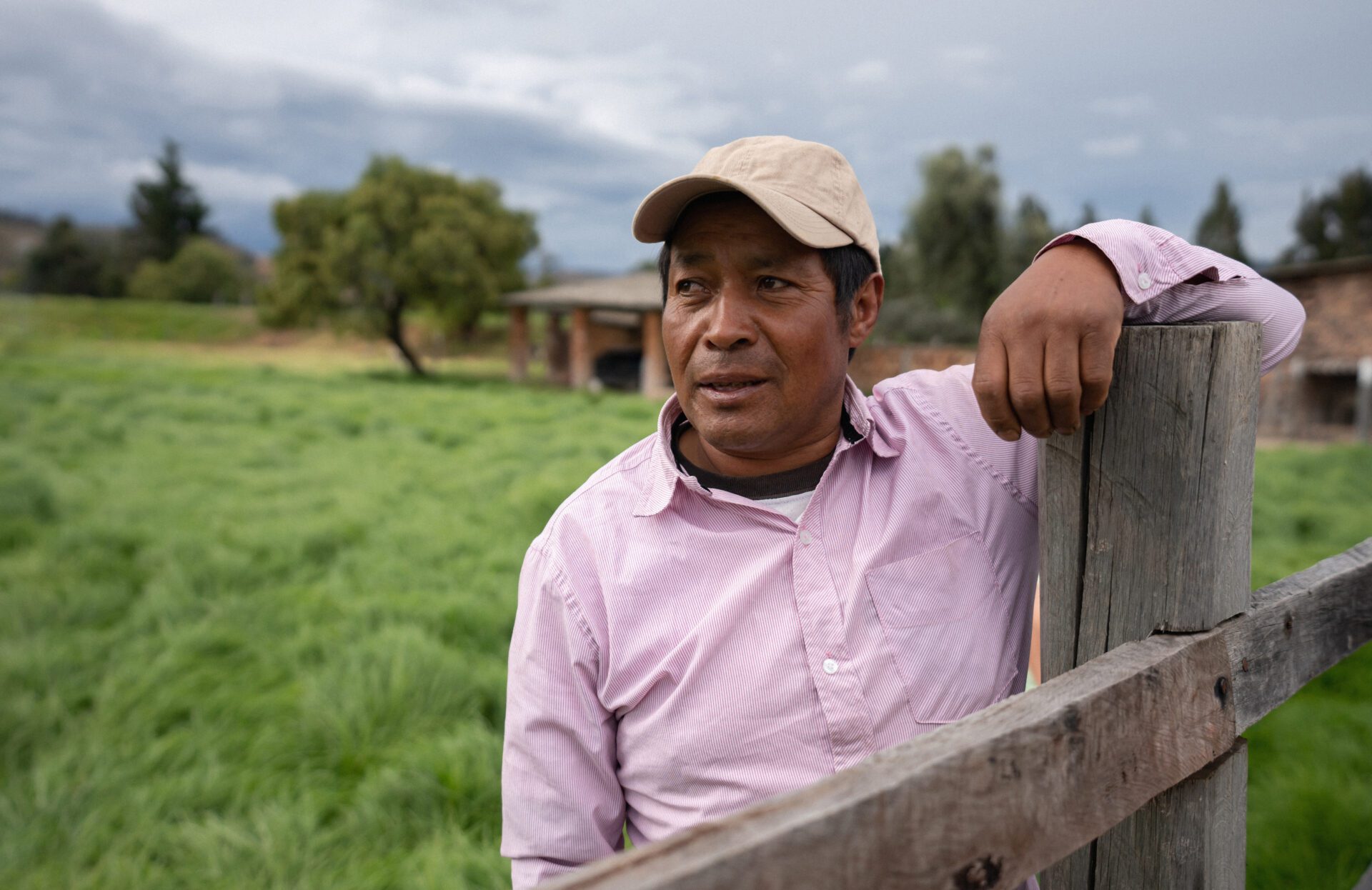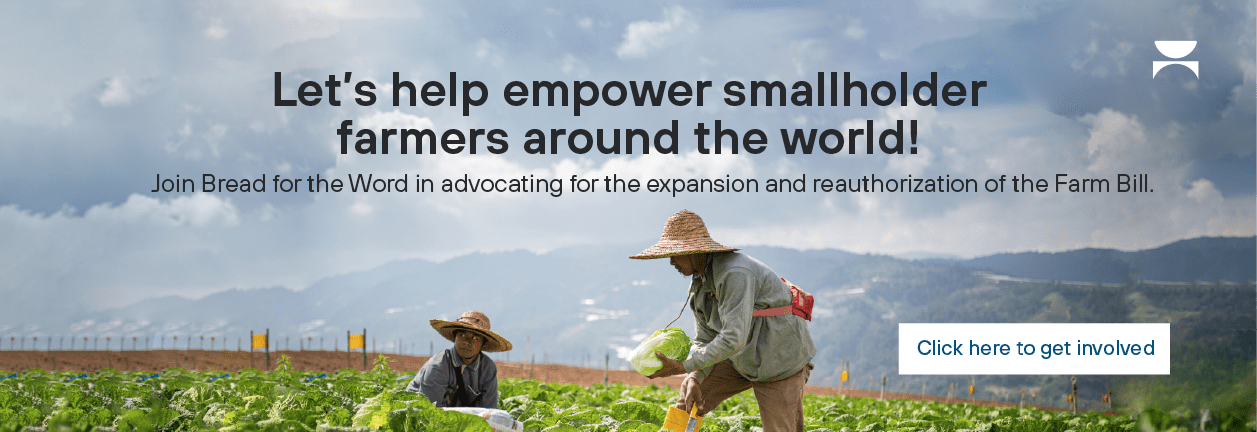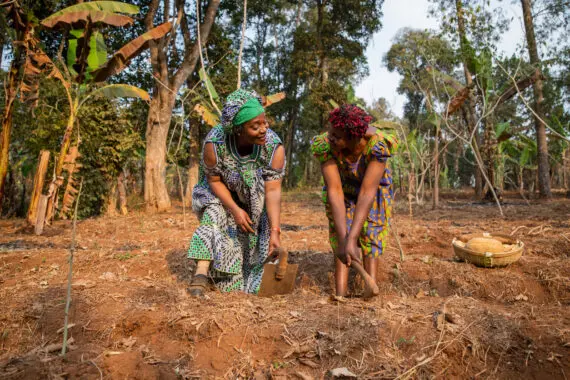Smallholder farmers are vital to food systems around the world. There are an estimated 600 million smallholder farmers working on less than 5 acres (2 hectares) of land, according to the Food and Agriculture Organization (FAO).

Many provide affordable, fresh, and nutritious food to their local communities. Yet they often face challenges due to limited resources, improper infrastructure, lack of funding, gender biases, or other socioeconomic factors. Moreover, smallholder farmers are often disproportionately affected by hunger. About three quarters of the estimated 828 million people experiencing hunger around the world live in rural areas, according to the United Nations — and many of them are farmers. Climate change has also played a role, as the increase in severe weather events and less predictable patterns can negatively impact harvests.
Nevertheless, smallholder farmers are an invaluable segment of the global agricultural industry. In this article, we’ll explore how smallholder farmers are defined, where they live and work, and what they grow by answering the following questions:
- What is a smallholder farmer?
- Where are most smallholder farmers located?
- What are the challenges of smallholder farmers?
- How can we empower smallholder farmers around the world?
What is a smallholder farmer?
A smallholder farmer is someone who depends on their own labor and resources to produce food or other agricultural products. They typically live in rural areas and sell at least some of their products or surplus crops while using a portion for home consumption or in-kind payments.
Smallholder farmers may be involved in one primary crop or many different crops throughout the year, depending on seasonal conditions and market opportunities. They rely on small plots of land for their livelihood, typically classified as agricultural operations of up to 24 acres (10 hectares) — most smallholder farmers cultivate less than 5 acres (2 hectares) of land.
Definitions for what constitutes a smallholder can vary and not only be based on size but factors such as involvement of family in labor, harvesting techniques, and economic profitability. The Ethical Trading Initiative (ETI) Smallholder Guidelines further details the distinctive characteristics of smallholders as farms that:
- produce limited volumes of food on small plots of land;
- have fewer resources than commercial or large-scale farmers;
- may be part of an informal economy;
- often depend on family labor; and
- are vulnerable in food supply chains.
The Impact of Smallholder Farmers
Smallholder farmers are an invaluable asset to the global food economy. Despite their size, smallholder farmers produce more than a third (around 35 percent) of the world’s food and provide up to 80 percent of the food supply in sub-Saharan Africa and Asia, according to the FAO. These growers play a key role in providing nutritious food to their local communities, maintaining ecosystems, and furthering sustainable agriculture.
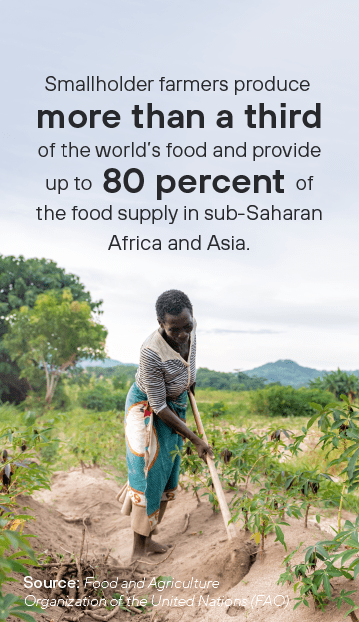
Growing numerous staple crops such as maize (corn), wheat, rice, coffee beans, cassava, and sorghum, smallholders often aid in the development and progress of effective food systems in low-income countries. As the FAO reports, “Out of the 2.5 billion people in [low-income] countries living directly from the food and agriculture sector, 1.5 billion people live in smallholder households.”
Despite growing food, smallholders are often disproportionately impacted by hunger, so addressing food insecurity and poverty in rural areas is often interconnected with addressing disparities faced by smallholders.
Smallholder Farmers’ Role in Sustainable Agriculture
Smallholder farmers play a significant role in environmental sustainability and conservation efforts by engaging in agroforestry, crop diversification, composting, and other environmentally-friendly practices. They help preserve local environments and agricultural land that may otherwise be lost due to industrialization and globalization.
Many smallholder farmers utilize composting waste materials from their own operations and rotate crops between fields every few years to keep soil healthy and fertile. This helps protect against erosion caused by heavy rains or windstorms that can destroy topsoil if left unprotected for too long.
Smallholder farmers are also vital stewards of ecosystems. Seeking to maintain biodiversity, they often assist in preventing overgrazing while providing habitats for wildlife such as birds who eat insects harmful to crops.
Where are most smallholder farmers located?
Smallholder farmers are a significant part of the agricultural landscape in many parts of the world, but they tend to be more prevalent in certain regions — particularly in low-income countries where a significant number of people work and live off the land.
Smallholder Farmers Around the World
Africa, Asia, and South America have high concentrations of smallholder farmers compared to other parts of the world. They grow and harvest crops that are abundant in their homeland and vital to local food systems. Maize (corn), for example, is the most important grain crop in Africa. Sorghum is another staple cereal grain grown widely across the continent.
Other staple foods grown by some smallholders include millet and wheat, though they tend to be produced commercially because the high demand makes it difficult for small farms to compete.Similar produce includes bananas, mangoes, guavas, and other popular fruits along with beans, cassava (tapioca), sweet potatoes, and yams.
What are the challenges of smallholder farmers?
Smallholder farmers are facing significant challenges worldwide. They often lack sufficient funds, work with improper infrastructure, or are vulnerable to the whims of supply chains that can favor large-scale farmers. Climate change plays a role in making it difficult for smallholder farmers to sustain their agricultural operations, too: severe weather events and changes in weather patterns have damaged land and created unpredictable conditions for harvesting crops.
Smallholder farmers may experience limitations based on their size and being in remote locations as well — all of which “hinder their ability to grow a prosperous business and provide food for their families.”
Unlike larger farming businesses, few smallholders have access to training, information, farm inputs, and financial support to look after the soil and improve their yields. Some smallholders may operate as part of an informal economy and lack official documents to show rights to their land. Consequently, this can limit their choices of what, when, and how to grow crops.
Farmers in low-income countries may struggle to maximize their harvests and turn profits. And over consecutive years, this impoverishes farmers, forcing them to sell their possessions or even their land, an unfortunate scenario that can deprive communities of a key source of food.
Other systemic factors that can hold smallholders back include gender inequality, low access to healthcare, unsafe water, and poor sanitation conditions. Globally, some common disparities among smallholder farmers are:
- Lack of safe water for growing crops: Many smallholder farmers do not have access to enough clean water for their crops and livestock, which makes production difficult and risky.
- Lack of access to markets: Smallholder farmers often lack access to markets where they can sell their produce and earn income from it, making it hard for them to make ends meet without relying on other sources of income like wage labor or handmade goods.
- Insufficient finances: Most smallholders do not take out loans from banks because they don’t qualify due to a lack of collateral assets like land titles.
- Limited access to technology: Smallholder farmers often do not have access to modern farming technologies like irrigation systems and smart fertilizing methods.
- Lack of education: Many smallholder farmers have not had formal or extensive education that would help them improve agricultural production and become more competitive in markets.
The Impact of Climate Change
Scientists have warned that the world is on track to reach climates that are 1.5 degrees Celsius (~2.7 degrees Fahrenheit) warmer as soon as 2027, and Africa is warming at an even faster rate.
Nearly all African countries are “expected to reach 2 degrees Celsius [~3.6 degrees Fahrenheit] warmer between 2025 and 2040, even though the continent accounts for less than 5 percent of the carbon emissions generated by human activities.”

What’s more, the Bill & Melinda Gates Foundation reports that over half of sub-Saharan Africa’s employment and up to 30 percent of its gross domestic product (GDP) relies on agriculture. “But by 2050, the areas currently providing 70 percent of the value of crop production will be victim to severe or extreme aridity and heat stress.”
And there are troubling trends in other parts of the world as well.
A recent McKinsey analysis on climate-smart agriculture found that smallholder farmers make up one of the populations most at risk from climate change.
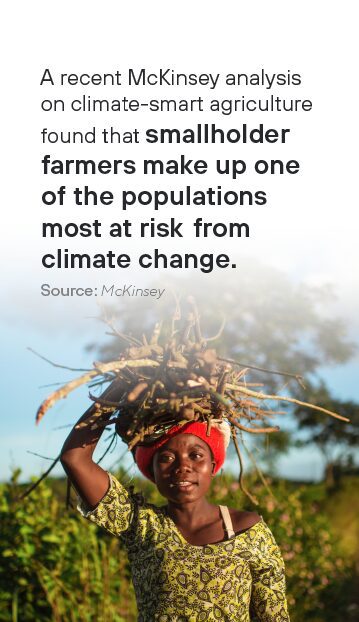
The research shows that in three countries in particular — Mexico, India, and Ethiopia — “nearly 80 percent of all smallholder farmers could be affected by at least one climate hazard by 2050. Moreover, climate change will affect ‘land suitability for crop production,’” and by 2050, India could lose 450,000 square kilometers of land for rice crops.
Governments, leaders, people of faith, and activists across the world must come together to address climate change. The people of low-income nations are proactively leveraging their own agency and resources to establish infrastructure that can withstand the impacts of climate change in their homelands.
Assistance from the U.S. government and international organizations can help by providing funding, training, and resources to further these efforts. The farm bill in particular lends major support to international food aid programs. Among the measures that should be strengthened are nutrition security efforts that support smallholder farmers and foster more equitable, sustainable food systems worldwide.
Challenges for Women Smallholders
Women do much of the farming in lower-income countries, comprising an average of 43 percent of the agricultural labor force and up to nearly 50 percent in sub-Saharan Africa and East and Southeast Asia. Yet they are often limited by gender biases that deny them access to credit, legal title and rights to land, and the ability to secure tools for farming.
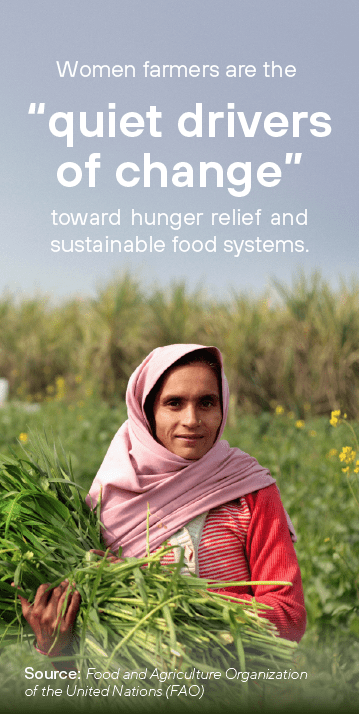
Nevertheless, women farmers are the “quiet drivers of change” toward hunger relief and sustainable food systems.
As Bread for the World has highlighted, “… one of the most cost-effective ways to combat global malnutrition is to invest in improving the lives of women farmers.” With access to the same resources as men, they could increase harvests on their farms by 20 percent to 30 percent and in turn lift 100-150 million people out of hunger.
How can we empower smallholder farmers around the world?
To empower smallholder farmers around the world, it is crucial that individuals, non-governmental organizations (NGOs), and communities advocate for leaders to prioritize programs and funding that address climate change. Overall, we must: mitigate the impacts of climate change; encourage sustainable agricultural practices; and increase access to funding and resources for smallholders.
Lawmakers should look toward making markets more accessible for smallholder farmers, while NGOs can help increase access to education and training programs. The promotion and support of sustainable agricultural techniques are also important so that not just smallholder farmers but all farmers can maintain and develop effective food systems.
How Empowering Smallholder Farmers Can Help Reduce Hunger
Currently, an estimated 828 million people are experiencing hunger around the world — 46 million more than the previous year, according to the World Health Organization. One of the most impactful ways to increase food security around the world is the empowerment of smallholder farmers, who produce about one-third of the world’s food supply.

In fact, when it comes to ending hunger, smallholder farmers are essential to efforts to reduce hunger and poverty around the world. During the 2021 United Nations Food Systems Summit, the UN issued a warning that the world will not succeed in meeting the Sustainable Development Goal to end global hunger by 2030 if smallholder farmers are not prioritized. Simply put, smallholder farmers are facing many challenges that could make achieving this unattainable.
With their dedication to providing nutritious and often affordable food for their local communities and families, smallholder farmers help reduce hunger. Providing better resources for these farmers can start with increasing funding opportunities.
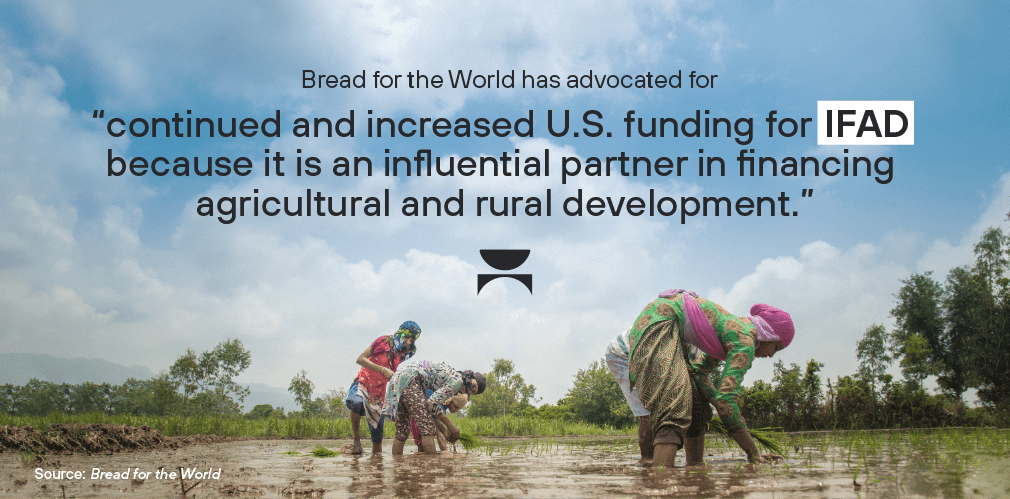
For example, the International Fund for Agricultural Development (IFAD) focuses on agriculture and food security in rural areas, making it the only multilateral development bank to do so. Bread for the World has advocated for “continued and increased U.S. funding for IFAD because it is an influential partner in financing agricultural and rural development. Since 1978, IFAD has funded projects worth more than $23 billion that have reached 518 million people.”
Other support should include technology, training, and educational programs that position smallholder farmers to develop sustainable, economically sound agricultural production.
Conclusion
Smallholder farmers are an important part of the global economy, and their contributions cannot be overlooked. With their dedication to growing nutritious, affordable food for their communities, smallholder farmers help feed people around the world while also keeping up sustainable agriculture practices. Yet not only do they face risks from climate change, poor infrastructure, financial disparities but they are also experiencing hunger at disproportionate rates.
There are many ways lawmakers and government leaders can increase support for smallholder farmers, such as providing more access to funding and training in new farming techniques and addressing the impacts of climate change. Governments should invest greater resources into rural areas where many smallholder farmers live so they have better access to technology, clean water, and public facilities — ensuring they can provide food for their families as well as their communities.
As individuals, we can play a role in empowering smallholders by advocating for the expansion and reauthorization of the farm bill. The legislation provides vital assistance for programs that support smallholder farmers and effective food systems around the world.
